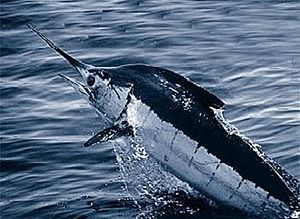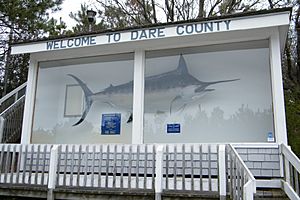Marlin facts for kids
Quick facts for kids Marlin |
|
|---|---|
 |
|
| An Atlantic blue marlin (Makaira nigricans) | |
| Scientific classification |
|
| Kingdom: | Animalia |
| Phylum: | Chordata |
| Class: | Actinopterygii |
| Order: | Istiophoriformes |
| Family: | Istiophoridae Rafinesque, 1810 |
| Type genus | |
| Istiophorus Lacépède, 1801
|
|
| Genera | |
|
|
Marlins are a group of amazing fish that belong to the Istiophoridae family. They are large, powerful fish found in the warm, tropical parts of the world's oceans. They are known for their incredible speed and their long, pointy snouts, which look a bit like a spear.
There are about 9 to 11 different kinds, or species, of marlins, depending on how scientists classify them.
Contents
Why Are They Called Marlins?
The common name "marlin" is thought to come from their resemblance to a sailor's tool called a marlinspike. This tool is used to untangle ropes and has a sharp, pointed end, much like a marlin's bill.
The scientific name for their family, Istiophoridae, comes from the Greek word istion, which means "sail." This name was chosen because some marlins, like the sailfish, have a very tall, sail-like dorsal fin on their back.
What Do Marlins Look Like?
Marlins have long, sleek bodies, which help them cut through the water quickly. They have a pointy, spear-like snout (often called a "bill"), and a tall, stiff fin on their back called a dorsal fin. This dorsal fin can stand up like a crest.
Marlins are also known for their ability to change color! They can light up their stripes just before they attack their prey, which might help them confuse or surprise their meal.
How Big Do Marlins Get?
Marlins can grow to be very large. Some of the biggest species include:
- The Atlantic blue marlin (Makaira nigricans), which can grow up to 5 m (16 ft) (about 16 feet) long and weigh as much as 820 kg (1,810 lb) (over 1,800 pounds)! That's heavier than a small car!
- The black marlin (Istiompax indica), which can also be over 5 m (16 ft) long and weigh more than 670 kg (1,480 lb) (about 1,470 pounds).
How Fast Are Marlins?
Marlins are among the fastest swimmers in the ocean. They are apex predators, meaning they are at the top of the food chain and hunt other fish. While you might hear exaggerated stories about their speed, they are definitely incredibly quick and agile hunters.
Where Do Marlins Fit in the Fish Family Tree?
Marlins are part of a larger group of fish called Istiophoriformes. Their closest relative is the swordfish, which is the only member of its own family, Xiphiidae. Scientists used to think marlins were closely related to Scombridae (like tuna), but newer genetic studies show only a slight connection.
Different Kinds of Marlins (Living Species)
Here are some of the main types of marlins and their relatives that are alive today:
| Image | Genus | Living species | Common name |
|---|---|---|---|
 |
Istiompax (Whitley, 1931) |
Istiompax indica | black marlin |
 |
Istiophorus (Lacépède, 1801) |
I. albicans | Atlantic sailfish |
| I. platypterus | Indo-Pacific sailfish | ||
 |
Makaira (Lacépède, 1802) |
Makaira nigricans (Lacepède, 1802) |
Atlantic blue marlin |
| Makaira mazara (Jordan & Snyder, 1901) |
Indo-Pacific blue marlin | ||
 |
Kajikia (Hirasaka & H. Nakamura, 1947) |
Kajikia albida (Poey, 1860) |
white marlin |
| Kajikia audax (Philippi (Krumweide), 1887) |
striped marlin | ||
 |
Tetrapturus (Rafinesque, 1810) |
Tetrapturus angustirostris (S. Tanaka (I), 1915) |
shortbill spearfish |
| Tetrapturus belone (Rafinesque, 1810) |
Mediterranean spearfish | ||
| Tetrapturus georgii (R.T. Lowe, 1841) |
roundscale spearfish | ||
| Tetrapturus pfluegeri (C. R. Robins & de Sylva, 1963) |
longbill spearfish |
Ancient Marlins (Fossil Species)
Scientists have found fossils of marlins that show they have been around for a very long time. The oldest clear marlin fossil is about 22 million years old! It's thought that they might have first evolved in an ancient sea called the Paratethys Sea.
Here are some of the ancient marlin groups known from fossils:
- †Morgula Gracia et al., 2022
- †Pizzikoskerma Gracia, Villalobos-Segura, Ballen, Carnevale & Kriwet, 2024
- †Prototetrapturus Gracia et al., 2022
- †Sicophasma Gracia, Villalobos-Segura, Ballen, Carnevale & Kriwet, 2024
- †Spathochoira Gracia et al., 2022
The timeline below shows when different groups of marlins and their relatives appeared in Earth's history:

Protecting Marlins
Marlins are very popular for sport fishing in tropical areas because they are so big and powerful. However, some species, like the Atlantic blue marlin and the white marlin, are now endangered because too many have been caught. This is called overfishing. It's important to protect these amazing fish so they can continue to thrive in our oceans.
In literature
In the Nobel Prize-winning author Ernest Hemingway's 1952 novel The Old Man and the Sea, the central character of the work is an aged Cuban fisherman who, after 84 days without success on the water, heads out to sea to break his run of bad luck. On the 85th day, Santiago, the old fisherman, hooks a resolute marlin; what follows is a great struggle between man, sea creature, and the elements.
Frederick Forsyth's story "The Emperor", in the collection No Comebacks, tells of a bank manager named Murgatroyd, who catches a marlin and is acknowledged by the islanders of Mauritius as a master fisherman.
See also
 In Spanish: Istiophoridae para niños
In Spanish: Istiophoridae para niños


